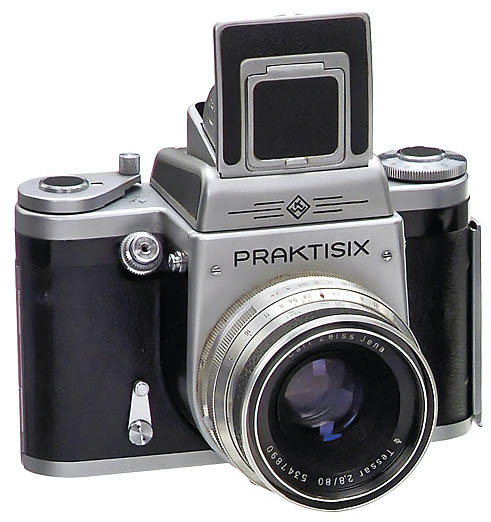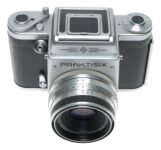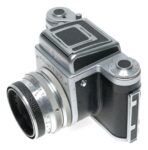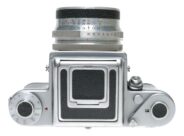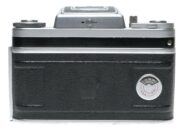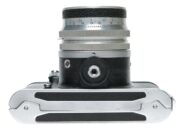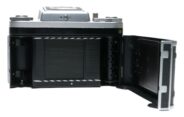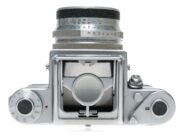Announced
Production status
Praktisix/Pentacon six system cameras
Praktisix
Medium format MF film SLR camera • Discontinued
Specification
| Format: | |
| Medium format 6x6 | |
Film type: | 120 roll film |
| Praktisix (Pentacon Six) [74mm] | |
| Shutter: | |
Type: | Focal-plane |
Model: | Mechanical |
Speeds: | 1 - 1/1000 + B |
| Exposure: | |
Exposure metering: | None |
Exposure modes: | Manual |
| Physical characteristics: | |
Weight: | 1275g |
Dimensions: | 165x119x118mm |
Manufacturer description #1
PRAKTISIX
THE LONG AWAITED BIG SIX
Big Features With Small Camera Ease
The World's first, fully internal automatic 6 x 6 cm (2 1/4" x 2 1/4"), Single-Lens Mirror-Reflex camera, with interchangeable lenses: Tessar f2.8, 80mm; Primotar f3.5, 80mm, Speeds 1/1000 to 1 second & B; Rapid Wind; Focal-Plane Shutter; interchangeable finders; regular and electronic flash synch.
Manufacturer description #2
PRAKTISIX, this new and finest singlelens reflex 6x6 cm incorporates for the first time fully automatic preset diaphragm and rapid film advance lever. Other refinements are: bright ground glass picture, focal plane shutter (speeds from 1 second to 1/1000-th), built-in delayed action selftimer, interchangeability of lenses, built-in synchronization for flash and strobe, exposure-counter, improved film advance-shutter cocking.
Manufacturer description #3
The Praktisix is a single lens reflex camera with focal plane shutter for the 6 X 6 cm (2 1/4 X 2 1/4) picture format. It possesses all the advantages of a modern precision camera, as there are:
- Fully automatic diaphragm;
- Focal plane shutter with speeds from 1 second to 1/1,000 second and B;
- Rapid wind lever;
- Interchangeable finder elements;
- Interchangeable field lenses;
- Shutter wind coupled to film transport;
- Lock against double exposures and blanks;
- Synchronization (X contact) for flash tubes and flash bulbs;
- Built in delayed action;
- Interchangeable lenses.
From the Popular Photography - ND (January 1957)
One of the most exciting new cameras to be introduced at Photokina was the Praktisix, a 2 1/4 x 2 1/4 single-lens-reflex camera with interchangeable lenses and fully automatic diaphragming through the body shutter-release button internally coupled to special spring-loaded lens diaphragms. A rapid-action, single-stroke lever positions the next negative and retensions the self-capping cloth focal-plane shutter which has 10 speeds from a full second to 1/1.000 second. The four-sided folding metal hood surrounding the Praktisix groundglass is instantly removable, and it was announced that when the camera is exported sometime in 1957, an accessory eye-level viewing prism will be provided.
The range of fully automatic interchangeable lenses provided is as exciting as the Praktisix itself. Most outstanding is a six-element East-zone Zeiss Flektogon 65-mm f/2.8 Gauss-type wide-field lens. Two 80-mm lenses, one a Zeiss Jena f/2.8, the other an f/3.5 Meyer Primotar-E, were also shown. Additional lenses, some of which were shown and others promised and described, included focal lengths from 65 to 400 mm, some with fully-automatic internally coupled diaphragm, and others with manually operated preset diaphragm arrangements.
Other valuable Praktisix features which indicate this camera's bright future are automatic film loading without the need to watch even the first negative numbr (although a window for viewing the paper-backing numbers is provided), an excellent frame counter built into the advance lever, continuous shutter-speed setting on a single selector wheel, electronic-flash synchronization at 1/25 second, and a hinged back providing easy access to the film chambers.
From the Practical Photography magazine (March 1962)
The PRAKTISIX is a single lens reflex camera with a fully automatic preset diaphragm mechanism which takes twelve 2 1/4 sq. negatives on a standard 120 roll film.
The Praktisix is fitted with an f/2.8/80-mm Tessar lens which will focus from 3 ft. to infinity and has apertures down to f/22. The lens diaphragm is fitted with a fully automatic preset control and the selected aperture is set on the control ring. When the shutter release is depressed, the diaphragm automatically stops down to the preset aperture and the action of the winding key returns the lens to full aperture for the next exposure. A small key provided on the side of the lens is spring loaded and can be raised to give previewing at the selected aperture.
The camera is fitted with a focal plane shutter with speeds from 1 second to 1/1,000 second plus brief time and delayed action. The shutter speeds are selected by a rotating ring on the top of the camera and speeds can be selected by turning the ring in either direction with the shutter cocked or uncocked. The shutter can be synchronized with either flashbulbs or electronic flash through a standard 3-mm coaxial outlet.
The viewing system consists of a 2 1/4-in. sq. ground glass screen, a mirror and the lens in use. By releasing a small button on the rear of the housing, the hood flies up to reveal the ground glass screen, and a magnifier which can be swung into position to facilitate focusing. A direct frame finder is provided for fast moving action shots.
The lever wind transports the film, cocks the shutter, repositions the viewing mirror, and also incorporates a frame counter. This is mechanically operated and shows the frame number after each successive exposure. When the last exposure has been made a red "F" appears in the frame number window.
The Praktisix is manufactured in Germany.
From the British Journal of Photography (January 4, 1963)
The appearance of the camera is not particularly elegant but it is well balanced. At first sight one has the impression that one of the Praktina or 'tica range of 35 mm cameras has overgrown, and in essence this is true, in that the Praktisix attempts to reproduce the features of the smaller format cameras. In fact the camera handles lightly and easily in a way its appearance may not suggest. The body is finished in a matt fairly coarse-grained silver chrome and covered in coarse grained black material. The camera is, by present-day standards of complication, a simple one - it is a purist's piece of equipment, providing the basic essentials. There is no exposure meter or cross coupling of speeds and apertures or an instant return mirror, for example.
The film transport is by lever wind situated on the right end of the top-plate.
The Praktisix shutter is a focal-plane type made of rubberised fabric traversing from right to left. It works as close to the film plane as most 35 mm camera focal plane shutters do - 3 mm. The shutter speeds are from 1 second to 1/1000th with "B", and a flash setting, at about 1/20th, they are set by a continuously rotating dial on the left end of the top-plate. Synchronization is X type, giving a shutter speed of 1/15th second for short-burning bulbs and 1/15th for long-burning.
The Praktisix is normally fitted with a viewing screen consisting of a rectangular plano-convex condenser ground on its flat surface. The condenser gives a bright image to the corners with a less critical eye centring than a fresnel lens, this advantage offsetting the slight field curvature it gives. This screen can be replaced if required by a flat ground glass screen or a screen incorporating a split-image range-finder. The hood for the viewfinder is self-erecting at the touch of a catch on the back, it is a straightforward hood with a large front flap containing the sportsfinder flap. The rear sight for the sportsfinder slides up from the back of the viewfinder hood. A magnifier is also provided, which pulls down from the back of the sportsfinder and in fact must be pulled down to allow the latter to be used. The magnifier covers the whole field and naturally the lens can be varied in power to suit individual eyesight.
The mirror is long and wide and there is a minimum of cut-off with long focus lenses; it flips up on to a felt pad and there is very little shutter and mirror noise considering the size of the components needed in a 6 X 6 focal-plane S.L.R.
The shutter release, which has a safety lock, is on the right of the camera front angled comfortably to the finder. The release works remarkably sweetly and is quite compatable in this respect to that on many 35 mm cameras. The button is threaded for standard cable release. A lever well down on the front of the camera gives a delay variable from 6 to 12 seconds.
As an alternative to waist-level viewing, the viewfinder hood can be removed by pushing it firmly forward and lifting it up, and a pentaprism hood placed in position. The bulk and weight of the camera are markedly increased when the pentaprism is fitted, and the feel becomes a little top weighted. In practice the finder is easy to use in all but very poor light.
The lens flange on the Praktisix, like the tripod bush pedestal, is part of the camera body casting, thus ensuring absolute rigidity and freedom from distortion with weighty lenses. The lens fitting is a triple bayonet type, the lens having a locating stud which slides into a groove on the camera flange. The lens is locked by turning a milled collar on the bayonet tabs on the lens mount. Thus there is no rotation and concomitant friction between the locating surfaces. The distance from lens flange to film plane is 75 mm, and the diameter of the throat is 60 mm. This large diameter is particularly useful in allowing the adaptation of a wide variety of lenses and specialised purpose units.
There are three standard lenses available for the Praktisix: 1:2.8/80 mm Jena T, the 1:2.8/80 mm Jena Bm, and the 1:3.5/80 mm Meyer Primotar E. The Jena T and Jena Bm lenses are semi-automatic. On winding on, the diaphragm opens to full aperture and then closes as the shutter is released. There are eight leaves to the diaphragm which is tripped by the release of pressure on a small spring-loaded metal stud as the shutter is fired. Both these lenses have linear click half-stop aperture scales, and a spring-loaded preview lever for assessing depth of field prior to exposure. The wide-angle 1:2.8/65 mm Flektogon for the Praktisix also has this feature. The other standard lens, the Meyer Primotar, has two index marks on a front ring. The red one opens up the lens with the shutter cocked, and the black one, when set to the required diaphragm setting, gives a preview. With this lens the full open diaphragm position is slightly wider in aperture than f/3.5 in order to brighten the viewing screen, but the lens shuts down to f/3.5 as the shutter is fired. The other interchangeable lenses have manually preset diaphragms.
The standard lenses focus down to one metre, and close-up work can be undertaken with a bellows extension unit or extension tubes.
Although larger than a 35 mm camera the Praktisix handles in the same way: the single stroke lever wind transports the film and cocks the shutter with an easy movement. The shutter release, so often a jerky item on roll-film reflexes, could hardly be improved upon. The Praktisix is a fully professional piece of apparatus, and it is a basic camera without frills. Less of a thoroughbred in appearance than its more expensive colleagues, it is very workmanlike and easily adaptable.
From the editor
Announced at Photokina 1956.
This camera was notoriously unreliable. The gears of the film transport were made of different metals and break easily. It also established the reputation that these cameras have for poor film frame spacing. Unfortunately its reputation was so bad that it has colored the reputation of the Pentacon Six TL which was a far better camera.
The weight and dimensions are indicated for the camera body with the Carl Zeiss Jena Tessar 80/2.8.
Similar cameras (3)
Medium format • Manual focus • Film • Singe-lens reflex • Praktisix (Pentacon Six) mount
| Model | Shutter | Metering | Modes | Year |
|---|---|---|---|---|
| Exakta 66 | M, 1/1000 | -- | M | 1984 ● |
| Kiev-60 TTL aka Киев-60 TTL |
M, 1/1000 | -- | M | 1984 ● |
| Kiev-6S [TTL] aka Киев-6С [TTL] |
M, 1/1000 | -- | M | 1971 ● |
